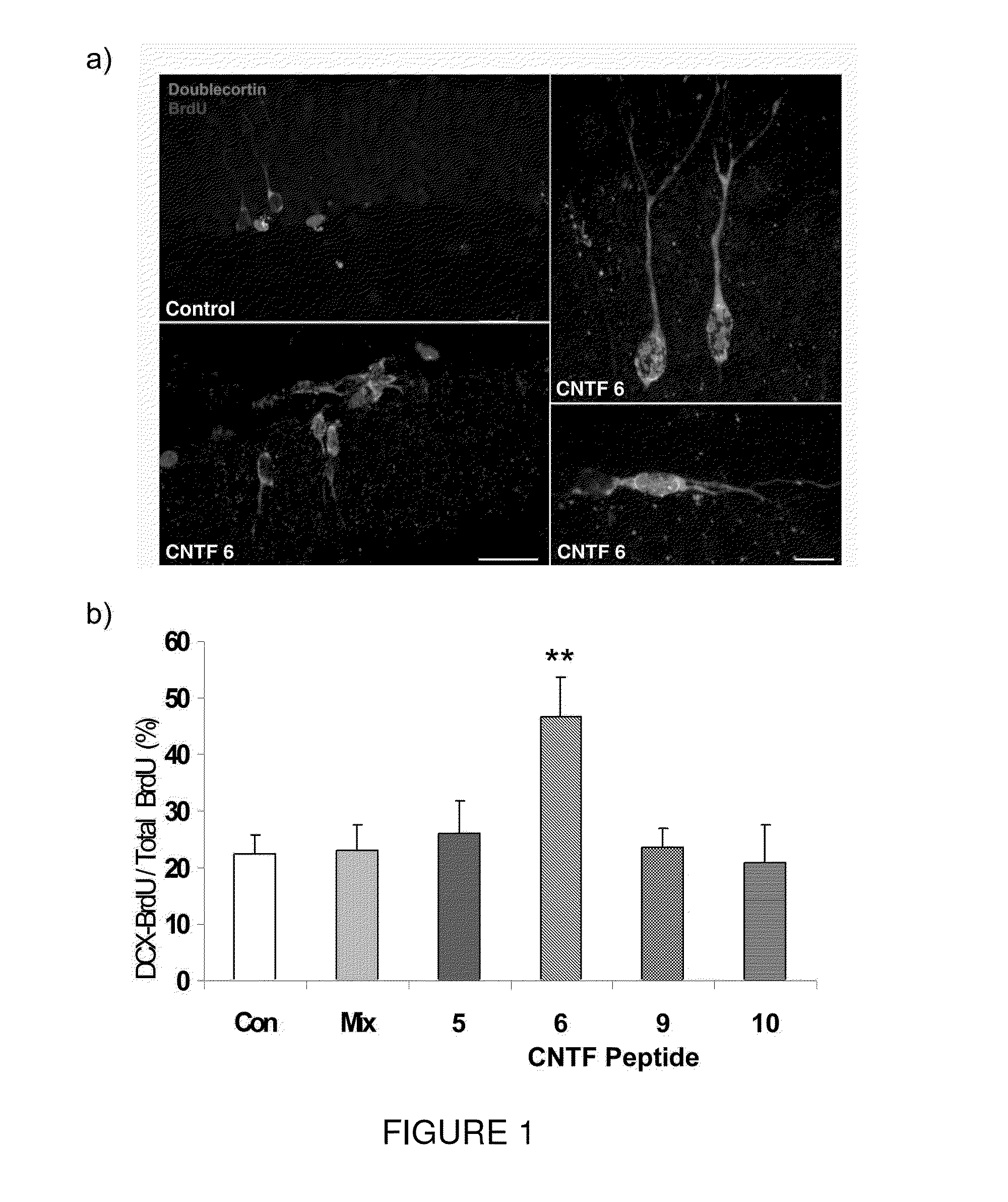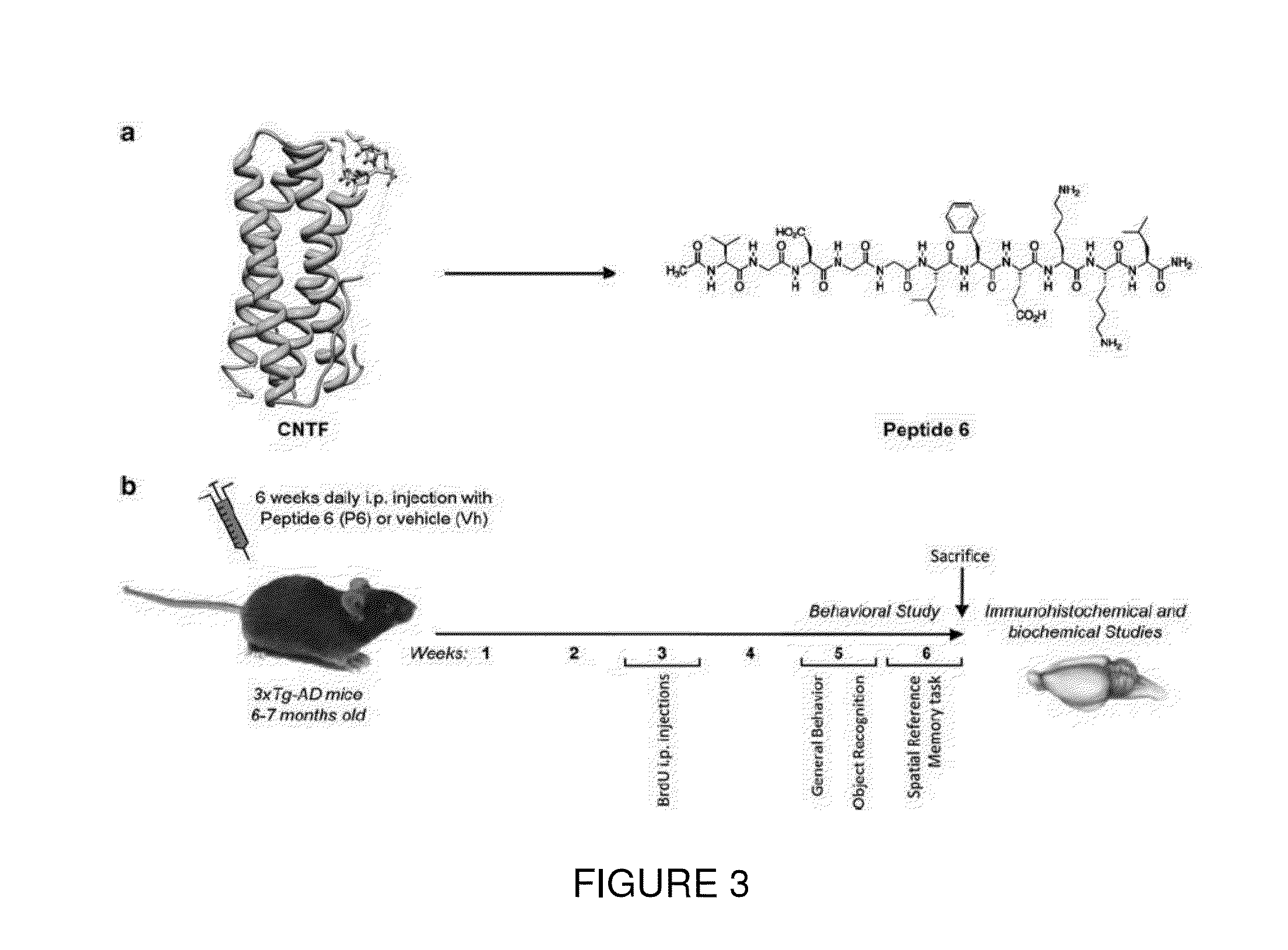Neurotrophic peptides
a neurotrophic and neurogenic technology, applied in the field of neurotrophic and/or neurogenic peptides, can solve the problems of inconvenient method, inconvenient direct bolus injection, and inability to deliver cntf systemically, and achieve enhanced neurotrophic and neurogenic activities, and enhance the ability to pass.
- Summary
- Abstract
- Description
- Claims
- Application Information
AI Technical Summary
Benefits of technology
Problems solved by technology
Method used
Image
Examples
example 1
[0109]Efficacy of the present invention in improving cognitive impairment has been established in animal models. More particularly, Peptide 6 induced a two fold increase in the differentiation of dentate gyrus progenitors into DCX (doublecortin) expressing cells in a 14 day treatment group of the mouse model C57 / BL6. As seen in FIG. 1, Peptides 5, 9 and 10 did not have any effect on the expression of DCX in BrdU labeled progenitors in the dentate gyrus. As seen in FIG. 2, Peptide 6 also caused a statistically significant increase in MAP2 and synaptophysin immunoreactivity in the dentate gyrus of treated mice as measured by mean pixel intensity in the outlined area of interest.
[0110]Behavioral tests employing Morris Water maze task-based memory acquisition, retention and recall paradigms have also been carried out. Two groups of 18 mice each were treated with Peptide 6 / Placebo containing implantable subcutaneous pellets with user specified timed release kinetics: 14 days for group 1 ...
example 2
[0114]The efficacy of present invention has further been established in animal models designed to evaluate the treatment of specific neurological diseases, such as Alzheimer disease (AD). In addition to the occurrence of numerous neurofibrillary tangles and Aβ plaques, neurogenesis and neuronal plasticity are markedly altered in AD. Although the most popular therapeutic approach has been to inhibit neurodegeneration, another is to promote neurogenesis and neuronal plasticity by utilizing the regenerative capacity of the brain.
[0115]In a transgenic mouse model of AD, 3xTg-AD mice, there is a marked deficit in neurogenesis and neuroplasticity, which occurs before the formation of any neurofibrillary tangles or Aβ plaques, as is associated with cognitive impairment. Peripheral administration of Peptide 6, restored cognition by enhancing neurogenesis and neuronal plasticity in these mice. Although this treatment had no detectable effect on Aβ and tau pathologies in 9-month animals, it e...
example 3
[0153]All in vivo studies for characterization of peptides (stereology and behavioral analysis) were performed on 8-10-month-old female retired breeders of C57B16 background. The animals were acclimatized for at least 3 weeks to exclude occasional pregnant mice from the studies. Mice were group-housed (3 animals per cage) with a 12:12 light:dark cycle and with free access to food and water. All procedures were conducted in accordance with approved protocols from our institutional Animal Welfare Committee.
[0154]Based on Peptide 6, a set of four tetrapeptides with overlapping residues to the sequence of the parent peptide CNTF 6 (see Table 3) was further constructed. These peptides, CNTF 6a-d, were synthesized on a commercial basis by the Pan Biotechnology Facility of Stanford University (Palo Alto, Calif.).
TABLE 3CNTF PeptidePosition in CNTFPeptide 6a145-148Peptide 6b146-149Peptide 6c147-150Peptide 6d148-151
[0155]To study neurogenesis, mice received subcutaneous implants of extended ...
PUM
| Property | Measurement | Unit |
|---|---|---|
| height | aaaaa | aaaaa |
| height | aaaaa | aaaaa |
| diameter | aaaaa | aaaaa |
Abstract
Description
Claims
Application Information
 Login to View More
Login to View More - R&D
- Intellectual Property
- Life Sciences
- Materials
- Tech Scout
- Unparalleled Data Quality
- Higher Quality Content
- 60% Fewer Hallucinations
Browse by: Latest US Patents, China's latest patents, Technical Efficacy Thesaurus, Application Domain, Technology Topic, Popular Technical Reports.
© 2025 PatSnap. All rights reserved.Legal|Privacy policy|Modern Slavery Act Transparency Statement|Sitemap|About US| Contact US: help@patsnap.com



